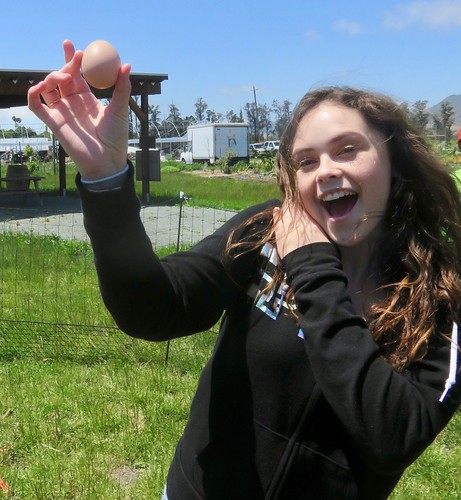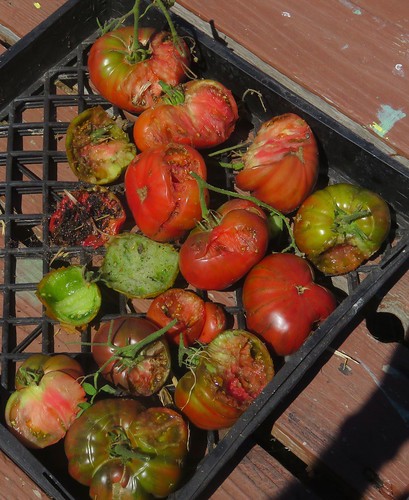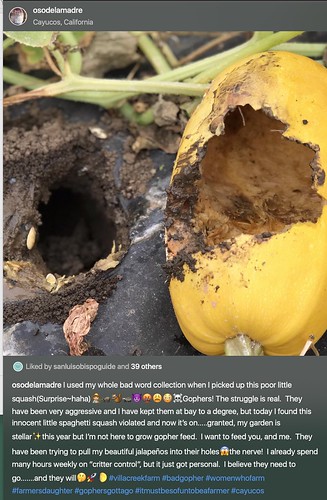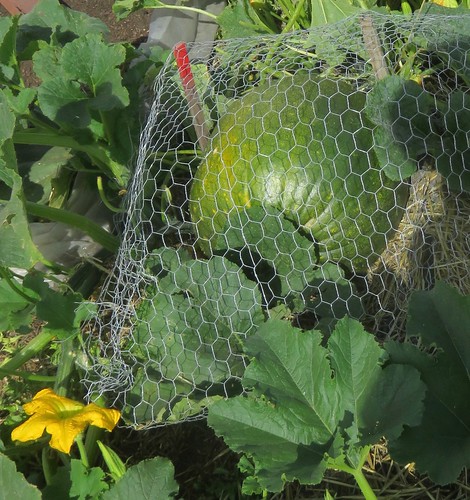Metta and Peta: Buddhist reflections on humans’ relations with other animals
An address to the White Heron Sangha, September 15, 2019
A variety of encounters with non-human animals over the past year have opened new areas of experience for me and left me mulling some troubling questions. They’ve led to conversations with family members, friends and co-workers, to reflections on past experiences, to scientific research and to guidance from Buddhist authorities.
One area of experience is my relationship with our two year old family dog, Sophie. Another is a series of cardiovascular incidents which have motivated me to refrain from eating animals for medical reasons. And another is my work at City Farm SLO, where the production of organic vegetables by small farmers and students is subject to the ravages of gophers and ground squirrels.
Sophie came into my life a year after the traumatic death of our previous family dog, a Yorkshire Terrier who had bonded closely with my wife Jan and our two live-in grandchildren but with whom my relationship was distant. By the time that Jan acquired Sophie, we were empty nesters, and I was a goner.
I was captivated by her physical beauty–tricolor coat, smooth soft fur, waving penant of a tail–by her speed, exuberance, and amiability at the dog beaches, and by those spaniel puppy eyes staring into mine with a meltdown gaze–the companionship of a fellow wonder-filled traveler on life’s journey. When I lie down for a nap, she jumps on the couch and pushes her muzzle against my cheek (no licking!) until we drop off breathing in synch. At night I sing her a lullaby as I lay her body, limp and heavy as an infant’s, down on her bed.
For fifty years the scientific consensus held to the assumption that no non-human animal could experience and perceive emotion. Lately that consensus has been challenged by the view that animals share many mental and emotional activities with humans, just as they share large portions of their DNA. This insight has been realized through longitudinal behavioral studies by researchers like Franz de Waal,[1] evolutionary studies like those demonstrating that puppy eyes are a product of ocular musculature developed through co-evolution with humans,[2] and through neuronal evidence of what dogs are actually thinking with fMRI brain scans.[3]
The fact that animals can exchange pure disinterested non-verbal love with humans has never been doubted by pet owners, of course, who often spontaneously extend their affection beyond their own to others’ pets and from there to the pets’ owners.
Those feelings of affection and benevolence, similar to the feelings of a parent for an infant, to me resemble the feelings of lovingkindness named by Buddhists with the Pali word Metta:
¦ metta is a multi-significant term meaning loving-kindness, friendliness, goodwill, benevolence, fellowship, amity, concord, inoffensiveness and non-violence. The Pali commentators define metta as the strong wish for the welfare and happiness of others (parahita-parasukha-kamana). Essentially metta is an altruistic attitude of love and friendliness as distinguished from mere amiability based on self-interest.[4]
When I am guided to perform Metta meditation, here at the Sangha or on retreat, along with old memories of a smiling radiance while on psychedelics, my present feelings for Sophie help me get into the zone. This connection led me to look into traditional Buddhist teachings about the relation of humans to other animals. Here are some that I found:
First, the philosophical
· Animals and humans share the same essential nature. We are not a separate class of beings to whom a separate class of ethical rules applies.[5]
· Animals have always been regarded in Buddhist thought as sentient beings.
· humans should develop universal loving kindness towards all living things that exist in the universe¦[which are] encompassed within this range of universal loving kindness or mettà [ Sabbe sattà bhavantu sukhitattà ]. ultimately humans and animals are part of a single family. They are all interconnected.[6]
· animals possess Buddha nature (according to the MahÄyÄna school) and therefore potential for enlightenment[7]
Then the ethical
· We should do all in our power to avoid causing suffering or death for any sentient being.
· all can feel pain; all should be spared suffering or dukha
· The first precept is to refrain from killing. It means honoring all life, not acting out of hatred or aversion in such a way as to cause harm to any living creature . . . This precept has always been understood by all denominations of Buddhism to apply to all sentient beings. Thich Nhat Hanh, ¦, tells us that, “In every country in the world, killing human beings is condemned. The Buddhist precept of non-killing extends even further, to include all living beings.”[8]
Finally, for those who choose to believe it, the karmic
· the doctrine of rebirth held that any human could be reborn as animal, and any animal could be reborn as a human.
· An animal might be a reborn dead relative, and anybody who looked far enough back through their series of lives might come to believe every animal to be a distant relative.
· The Buddha expounded that sentient beings currently living in the animal realm have been our mothers, brothers, sisters, fathers, children, friends in past rebirths.[9]
There is a notable contrast between Buddhism’s inclusion of non-human animals as objects of ethical concern and their exclusion from the ethics of western Abrahamic religions, Judaism, Christianity and Islam.
· ¦ the First Precept, offers a moving example of humans’ abilities to apply ethics to nonhuman animals on questions about animal protection for companion animals, food animals, entertainment animals, wildlife, and captive animals” and animals used for experimental research.[10]
The largest animal rights organization in the world, according to its website, is PETA, short for “People for the Ethical Treatment of Animals,” “with more than 6.5 million members and supporters.” Its slogan echoes the Buddhist principles listed earlier:
· Animals are individuals with their own needs and desires. They exhibit joy, pain, devotion, and fear.
· “Animals are not ours to eat, wear, experiment on, use for entertainment, or abuse in any other way.”
Although some animal rights people find even PETA’s stances too compromising, the organization has taken high profile positions and dramatic actions in support of these principles as applied to a range of specific issues.
· PETA focuses its attention on the four areas in which the largest numbers of animals suffer the most intensely for the longest periods of time: in laboratories, in the food industry, in the clothing trade, and in the entertainment industry. We also work on a variety of other issues, including the cruel killing of rodents, birds, and other animals who are often considered “pests” as well as cruelty to domesticated animals.[11]
Two of the issues relevant to both Metta and Peta have affected me directly: vegetarianism and pest control.
Buddhist teachings generally forbid or frown upon eating animals
· The Mahayana scriptures portray the Buddha as requiring his followers to be strict vegetarians in all circumstances. In the Lankavatara Sutra, the Buddha is quoted as saying, “I have not permitted meat eating by anyone. I do not permit it. I will not permit it.” In this same scripture, he gives the reason, “If meat is not eaten by anybody for any reason, there will be no destroyer of life.”[12]
Peta’s stance on eating animals responds to their cruel treatment under modern conditions of industrial meat production. They adopt a position of veganism significantly more restrictive than vegetarianism.
· Vegans do not consume, wear, purchase, or use anything that is made from an animal. This means vegans abstain from eating animal flesh (meat), eggs, honey, and dairy “products” such as milk, cheese, and yogurt.
In both principle and practice, Buddhism presents a less consistent position in regard to the prohibition of meat:
· According to the Vinaya rules established and followed by the Buddha himself, Theravada monastics are mendicants. They do not grow or normally cook their own food; they beg for it. Being dependent on what is donated to them each morning, they are not required to be vegetarian,
· Shakyamuni Buddha died of a stomach ailment caused or aggravated by eating pork. Buddhist vegetarians have sometimes considered this fact scandalous and denied it, but it is consistent with what is known about the early Buddhist community.
· There are no reliable statistics on the number of Buddhists who are vegetarian, but worldwide it is probably about half. In the West, the percentage may be a good bit lower.[13]
My own long history with vegetarianism reflects analogous ambiguity, some resulting from changes of ideas and values and some from changes in external circumstances or household compromises.
Living in New York in the late sixties, Jan and I adopted “granola” vegetarianism as a strengthener of our counter-culture identity and community as well as a complement to the practice of yoga and meditation.
Relocating to an old homestead in coastal British Columbia in 1970, we started eating meat again as part of a back-to-the-land ecology in which our surplus garden produce went to chickens, goats and pigs, in which it seemed ideologically pure to eat meat that we had raised and slaughtered ourselves, in which that killing intensified the drama of giving over to natural cycles of life and death, and also because of a pregnant and nursing mother’s irresistible appetite for protein.
After several years of its rigors, the satisfactions of this regime lost their thrill and were outweighed by the unpleasantness of the animals’ fear and by having to clean up the bloody messes. The reintroduction of a steady income allowed for purchases of meat from the grocery store, and abstract moral concerns gave way to the imperatives of family, career and politics. Why worry about animal welfare when humans were carrying out genocide against one another and destroying the earth.
Forward fast to the 2000’s.
· I’m teaching Environmental Writing and Literature in the English Department at Cal Poly. I take my students on field trips to the abbatoir (slaughterhouse), poultry unit and dairy. It makes us all uneasy to hear cattle braying outside the slaughterhouse, see debeaked chickens crowded in cages, and touch day-old calves on short tethers separated from their mothers.
· Michael Pollan comes to Cal Poly and expounds on the brutality and environmental costs of CAFO’s and other forms of industrial agriculture and expounds his mantra: eat food, not too much, mostly plants.
· Dismayed, I watch people at Costco loading their carts with gargantuan packages of beef and pork, but then I grab a smaller one of organic chicken breasts.
Now it’s 2019
For the last five years of retirement, much of my time has been spent at City Farm, a nineteen acre property owned by the City of SLO and managed by a tiny non-profit of which I am default President.
My colleagues and I work in an educational garden alongside continuation high school students in a twice weekly Farm class, and visiting elementary students from all over county. We harvest organic produce year round, cook it onsite, and take as much as we can home: right now, corn, tomatoes peppers, lettuce, eggplant, squash, berries and melons.
A few months ago one of our Board members, Kayla, donated 7 hens and a rooster she raised from chicks along with a coop she secured for nothing.
Whenever we arrive at the farm, the chickens prance over to the edge of the run to greet me and Sophie, who approaches them with the same brief display of affection she offers to people and other dogs. They cluck and crow and dance for the children who delight to see them.
Although we keep them to provide food and manure, they are easy to love as fellow living beings.
These chickens are among the thousands of avian species descended from dinosaurs. A recent book, The Genius of Birds, presents research delineating their powers of perception, memory, movement, navigation and expression that equal or exceed humans.
Within the last six months I’ve been diagnosed with coronary artery disease and suffered a small stroke. My doctors have put me on what they say is life-saving medication and strongly encouraged me to reduce cholesterol in my diet. That means meat can kill me. With Jan’s full collaboration there’s no more of it in our meals at home. It turns out that in addition to our farm produce, at Trader Joe’s we can find a large selection of raw and preprepared foods for vegetarians and vegans. Cooking is simpler and less smelly and there’s no problem controlling my weight.
This change has not been driven by ideas or moral persuasion. I don’t identify as a “vegetarian” or watch videos about animals’ suffering. But, in the store and at dinner time I must admit, I feel a little cleaner. I’m reminded of the Pali term, “kleshas,” that’s sometimes translated as “defilement”:
· Kleshas, in Buddhism, are mental states that cloud the mind and manifest in unwholesome actions. Kleshas include states of mind such as anxiety, fear, anger, jealousy, desire, depression, etc.[14]
But I’ve also rediscovered that farming, no matter how idyllic, local and organic, has its dark side.
My co-workers and our students labor for months to foster the growth of our plants from seeds or starts. Every day we water, mulch, fertilize, weed and trellis those thousands of little living things until they reach maturity and return our care with bounteous gifts.
But again and again the cycle is aborted and the fruit is spoiled by what we experience as the cruelty of animals toward people, specifically the attacks of gophers and ground squirrels.
They wait until the cucumbers are crisp or the melons are sweet and then break their protective skins with their little teeth, often taking just one bite and moving on to the next casualty. They slice irrigation lines and undermine our toolsheds.
Fellow local organic farmers share this pain:
We build owl boxes and spray expensive fox pee, but only one thing can actually control the damage: traps. I probe the dirt around every fresh gopher excavation in search for a tunnel six inches below. If I succeed in finding one, I augur down and insert the tubular trap. First thing in the morning I look for the yellow sign that the trap has snagged and crushed its underground victim. When it has, I pull it up triumphantly, dump the corpse in the trash, and salute the rescued zucchinis.
For ground squirrels, I bait the squirrelinator, a wire cage with one way gates. If it has worked to ensnare a panicked little rodent, I get the pellet gun and dispatch it at close range, hopefully with no more than three shots. Afterwards, I see myself as Amon Goeth the Nazi commander in Schindler’s List, who walks up to an unsuspecting Jewish woman and shoots her point blank in the head.
The raw experience of activating my own killer instinct teaches me about the first precept by highlighting its opposite. I try to come to terms with the violence I perpetrate by seeing it as an essential part of agriculture and of all of nature. We kill in order to live.
I’m somewhat consoled watching a beautiful White Heron wandering in the garden do the same thing.
Yes, a white heron!
I go online to search for guidance from the authorities. An article in Tricycle, entitled “How to Get Rid of Pests and Bugs the Buddhist Way” offers this advice:
· First of all, because it is quick, harmless, and vouched for by many Buddhists, one should start the campaign to oust the unwanted critters by standing in their presence and chanting [the Metta prayer] directly to them
The next recommendation is more practical
· The three basic factors of a Buddhist approach to pests are to prevent, repel, and remove. [15]
This is similar to advice by experts from the Rodent Exterminator Company called Caddyshack who offered it to us without much expectation of success.
Nevertheless, I can report that for the last two weeks, there has been no sign of the gophers’ return. And since the ground squirrels have outsmarted the traps, we raise the tomatoes on trellises, harvesting them before they fully ripen, and accepting the fact that a significant proportion must be shared. As to melons and pumpkins, we are experimenting with building protective cages around the fruit out of chicken wire.
I’m relieved to be spared the need to kill more cute furry creatures, but expect it to return.
If it arises, I will rely on Buddhist assurances like this:
· Of course precepts, or guidelines for following the dharma, are training principles, and Buddhists undertake to observe them to the best of their abilities. At times certain conditions may not allow us to rigidly adhere to the precepts and no one can live through life without ever breaking them. It is at such times that we must use our common sense and human intelligence to make the best decisions.[16]
or this
· if your food supply depends on a field of grain and vegetables, an animal or insect that comes to eat and destroy that field is also your enemy, just as surely as a person who comes to pillage your land. If you take forceful action to defend your food, and thereby kill some of the pests it is not against the true spirit of Ahimsa. You have used force to continue your own life, not to inflict harm for no reason at all.[17]
Or I will remember equally flexible Peta guidelines like these
· All animals have feelings and have a right to live free from unnecessary suffering”regardless of whether they are considered “pests” or “ugly.”
· As in our dealings with our fellow humans, the determination of when lethal defense against insects and animals is acceptable must be judged on a case-by-case basis, taking into account the level of the threat and the alternatives that are available.[18]
As I reach the end of my allotted thirty minutes, I’d like to leave you with some conclusions. But alas, investigating this compelling subject goes no further than wishy-washy proclamations about pest control from spokespersons for both Metta and Peta, and leaves me quite uncertain about how I will react to the future moral dilemmas it presents.
As to the ethics of eating meat, the moral issues are less ambiguous. I admire the categorical stance taken by Peta and I feel supported in my present dietary choices by Buddhist advocates for abstention. But given my long inconsistent history in this regard, if my cholesterol count should drop, I’m not certain I’ll always say no to a barbeque.
One thing I can say I know for sure is that I do love Sophie!
[1] https://www.nytimes.com/2019/02/25/books/review/frans-de-waal-mamas-last-hug.html
[2] https://www.nationalgeographic.com/animals/2019/06/dogs-eyebrows-humans-communication/
[3] https://www.smithsonianmag.com/science-nature/what-fmri-can-tell-us-about-the-thoughts-and-minds-of-dogs-8390613/
[4] https://www.accesstoinsight.org/lib/authors/buddharakkhita/wheel365.html
[5] http://fore.yale.edu/religion/buddhism/
[6] https://www.urbandharma.org/udharma7/animalrights.html
[7] https://en.wikipedia.org/wiki/Animals_in_Buddhism
[8] Seeking the Heart of Wisdom: The Path of Insight Meditation by Joseph Goldstein and Jack Kornfield. Shambhala Publications: Boston, 1987.
[9] https://en.wikipedia.org/wiki/Animals_in_Buddhism
[10] Paul Waldau. The Oxford Handbook of Buddhist Ethics
[11] https://www.peta.org/
[12] https://www.humanesociety.org º sites º default º files º docs º buddhist-te…
[13] “Buddhist Perspectives on Food and Agricultural Ethics,”
David R. Loy*Independent Scholar, Boulder, CO, USA, https://link.springer.com/referenceworkentry/10.1007%2F978-94-007-6167-4_110-2
[14] https://en.wikipedia.org/wiki/Kleshas_(Buddhism)
[15] https://tricycle.org/trikedaily/kill-impulse-compassionate-solutions-your-favorite-pest/
[16] https://tricycle.org/trikedaily/kill-impulse-compassionate-solutions-your-favorite-pest/
[17] https://www.dadaveda.com/articles/what-does-a-buddhist-monk-do-about-pests-in-the-garden/
[18] https://www.peta.org/about-peta/faq/what-about-insects-and-other-pests/










